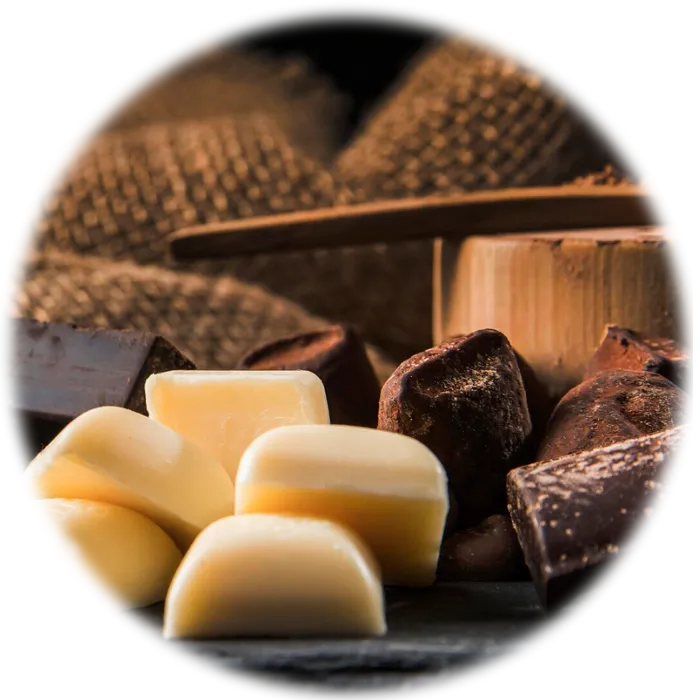
Nutritional properties of Cocoa Butter
Energy :
900.00 Kcal / 100g
Category : Oils and Fats
Group : Cooking Oils & Specialty Fats
Composition And Nutritional Value :Cocoa butter is a natural fat extracted from cocoa beans, primarily composed of triglycerides, with a mix of saturated and unsaturated fatty acids. It contains stearic acid and oleic acid, which provide moisturizing and emollient properties, making it a popular ingredient in both skincare and culinary products. Cocoa butter is rich in antioxidants, including flavonoids, which can help protect the skin from free radical damage and improve overall skin health. It also contains small amounts of vitamins E and K, contributing to its skin-healing and anti-aging properties. While it is widely used in cosmetics, cocoa butter is also an edible fat that adds flavor and texture to foods like chocolates.
Health Benefits : Cocoa butter has numerous benefits for both skin and overall health. As a skincare ingredient, its moisturizing and soothing properties help to keep the skin hydrated, reduce the appearance of scars and stretch marks, and improve skin elasticity. Cocoa butter’s high antioxidant content helps fight free radicals, contributing to anti-aging effects and promoting healthier skin. When consumed in moderation, cocoa butter can offer cardiovascular benefits due to the presence of oleic acid, a monounsaturated fat that helps reduce LDL (bad) cholesterol. Additionally, cocoa butter is known to support the healing of dry, rough, or irritated skin conditions, such as eczema and dermatitis.
Culinary Uses : In culinary applications, cocoa butter is primarily used in chocolate-making, as it imparts a smooth texture and rich, creamy flavor. It is an essential ingredient in high-quality chocolate and confectionery products, contributing to the mouthfeel and glossiness of finished products. Cocoa butter is also used in some baked goods and desserts, such as cakes, cookies, and creams, where it provides a unique flavor and smooth texture. It can also be used in the preparation of certain beverages, like hot cocoa. Although cocoa butter is edible, it is usually blended with other ingredients to create products rather than consumed on its own due to its firm texture at room temperature.
Types : Cocoa butter is available in both refined and unrefined forms. Unrefined cocoa butter, often called "pure" cocoa butter, retains more of the natural cocoa flavor and aroma, making it ideal for skincare products or use in chocolates that require the signature cocoa scent. Refined cocoa butter, which undergoes processing to remove impurities and reduce the strong flavor, is often used in food production and cosmetics, where a milder flavor is preferred. Cocoa butter can also vary in quality depending on the processing method, with higher-quality cocoa butters typically being cold-pressed or minimally processed to retain more of their beneficial compounds.
Shopping And Storage Tips : When shopping for cocoa butter, look for products labeled as "pure," "unrefined," or "cold-pressed" for skincare applications to ensure you are getting a high-quality product with maximum nutrients. For culinary use, choose refined cocoa butter that has been processed to reduce the flavor and aroma. Ensure that the product is sourced from a reputable brand to guarantee its authenticity and purity. Cocoa butter should be stored in a cool, dry place, away from direct sunlight and heat, to maintain its quality. In warmer climates, it may be stored in the refrigerator to prevent it from melting or becoming too soft. Cocoa butter can also be frozen for long-term storage without significant loss of quality.

